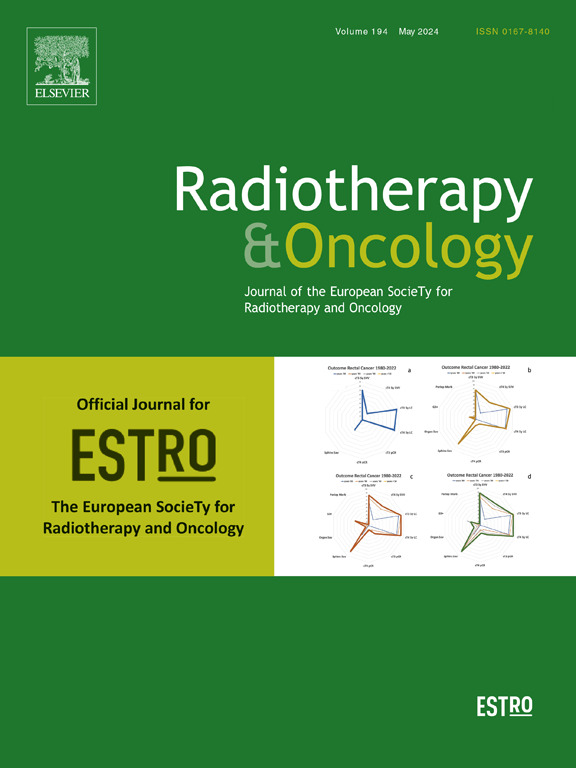ESTRO-EANO关于IDH突变型WHO中枢神经系统2级和3级弥漫性胶质瘤靶区划分和放射治疗的指南。
IF 5.3
1区 医学
Q1 ONCOLOGY
引用次数: 0
摘要
目的:本指南将讨论 IDH 突变 2 级和 3 级弥漫性胶质瘤的放射治疗管理,采用最新的 2021 年 WHO(第 5 版)脑肿瘤分类,重点关注:成像模式、肿瘤体积划分、照射剂量和分次照射:ESTRO指南委员会中枢神经系统分组提名了15位欧洲专家,由他们确定本指南的问题。成立了四个工作小组,分别负责解决成像、靶体积划分、放射技术和分次照射方面的具体问题。对文献进行了检索,并对现有文献进行了讨论。采用改良的德尔菲两步法,以多数票通过的方式做出决定或强调不确定的领域:确定和讨论的关键问题包括确定靶点定义所需的成像、靶点划分和边缘大小,以及包括质子治疗等不同计划技术在内的治疗技术方面:GTV应包括术后残留的肿瘤体积以及切除腔。如果 T1 成像上的增强病灶表明有残余肿瘤,则应将其包括在内。对于 2 级肿瘤,T2/FLAIR 异常应包括在 GTV 中。对于 3 级肿瘤,T2/FLAIR 异常也应包括在内,但被认为是水肿的区域应从 GTV 中省略。建议 2 级肿瘤的 GTV 至 CTV 扩大 10 毫米,3 级肿瘤扩大 15 毫米。建议 2 级肿瘤的治疗剂量为 50.4 Gy,28 次分割;3 级肿瘤的治疗剂量为 59.4 Gy,33 次分割。IMRT放射技术是首选方法。本文章由计算机程序翻译,如有差异,请以英文原文为准。
ESTRO-EANO guideline on target delineation and radiotherapy for IDH-mutant WHO CNS grade 2 and 3 diffuse glioma
Purpose
This guideline will discuss radiotherapeutic management of IDH-mutant grade 2 and grade 3 diffuse glioma, using the latest 2021 WHO (5th) classification of brain tumours focusing on: imaging modalities, tumour volume delineation, irradiation dose and fractionation.
Methods
The ESTRO Guidelines Committee, CNS subgroup, nominated 15 European experts who identified questions for this guideline. Four working groups were established addressing specific questions concerning imaging, target volume delineation, radiation techniques and fractionation. A literature search was performed, and available literature was discussed. A modified two-step Delphi process was used with majority voting resulted in a decision or highlighting areas of uncertainty.
Results
Key issues identified and discussed included imaging needed to define target definition, target delineation and the size of margins, and technical aspects of treatment including different planning techniques such as proton therapy.
Conclusions
The GTV should include any residual tumour volume after surgery, as well as the resection cavity. Enhancing lesions on T1 imaging should be included if they are indicative of residual tumour. In grade 2 tumours, T2/FLAIR abnormalities should be included in the GTV. In grade 3 tumours, T2/FLAIR abnormalities should also be included, except areas that are considered to be oedema which should be omitted from the GTV. A GTV to CTV expansion of 10 mm is recommended in grade 2 tumours and 15 mm in grade 3 tumours. A treatment dose of 50.4 Gy in 28 fractions is recommended in grade 2 tumours and 59.4 Gy in 33 fractions in grade 3 tumours. Radiation techniques with IMRT are the preferred approach.
求助全文
通过发布文献求助,成功后即可免费获取论文全文。
去求助
来源期刊

Radiotherapy and Oncology
医学-核医学
CiteScore
10.30
自引率
10.50%
发文量
2445
审稿时长
45 days
期刊介绍:
Radiotherapy and Oncology publishes papers describing original research as well as review articles. It covers areas of interest relating to radiation oncology. This includes: clinical radiotherapy, combined modality treatment, translational studies, epidemiological outcomes, imaging, dosimetry, and radiation therapy planning, experimental work in radiobiology, chemobiology, hyperthermia and tumour biology, as well as data science in radiation oncology and physics aspects relevant to oncology.Papers on more general aspects of interest to the radiation oncologist including chemotherapy, surgery and immunology are also published.
 求助内容:
求助内容: 应助结果提醒方式:
应助结果提醒方式:


